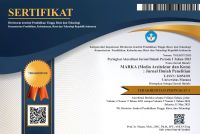Penerapan Kurikulum Komprehensif Montessori, Waldorf Dan Reggio Emilia Pada Desain Interior Kindergarten
Abstract
Education is one of important aspect for everyone to have a better life, build a good character, both from nature or nurture, attitude and behaviour which becomes a strong grip and base for every individual to be able to live a social life among the community. In order for that, children from 0-5 years old which is in rapid growth phase commonly known as golden age they needs full attention of both parents because intelligence potential has been formed to absorb information and receive stimuli they get from the surrounding environment, and through this process, children sees their parents as role model. However, due to the pressure of hustle environment, some parents can’t give their full attention to their children. Therefore, educational institutions are needed to support the teaching and learning process with good facility and standardization. This design uses a method created by William M. Pena namely problem seeking with aims to propose an alternative Bambino Preschool interior design that uses 3 comprehensive curriculum, Montessori, Waldorf and Reggio Emilia with the application of the "Dreamy Second Home" concept which expected to be useful and encourage children's learning enthusiasm to improve the quality and abilities of children in Indonesia.
Downloads
References
Aminah, S., Agustin, M., Studi, P., Guru, P., Anak, P., Dini, U., Pendidikan, F. I., Indonesia, U. P., & Pembelajaran, M. (2021). IMPLEMENTASI MODEL PEMBELAJARAN WALDORF DI TAMAN KANAK-KANAK. 18(229), 39–48. https://doi.org/10.17509/edukids.v18i1.24235
Ching, F. D. K. (2015). Architecture Form, Space, & Order Fourth Edition. In Journal of Chemical Information and Modeling (Vol. 53, Issue 9).
Dewi, S. L. (2022). Pengaruh Pembelajaran Berbasis Permainan pada Pendidikan dan Perkembangan Anak Usia Dini. Aulad: Journal on Early Childhood, 5(2), 313–319.
Dianto, Y. (1985). Dasar-dasar Arsitektur. MDS.
Dwimirnani, P. (2011). A-Z Seputar Ruang Tamu. Griya Kreasi.
Goodwin University. (2020). A Look Inside the Reggio Emilia Classroom Environment.
Hidayatulloh, M. A. (2014). Lingkungan Menyenangkan dalam Pendidikan Anak Usia Dini: Pemikiran Montessori. Nadwa: Jurnal Pendidikan Islam, 8(1), 139–154.
Huraerah, A. (2018). Kekerasan terhadap anak. Nuansa Cendekia.
Incite Architecture. (2016). Public, Semi-Public, and Private Spaces. http://incitearchitecture.com/news/2016/3/31/public-semi-public-and-private-spaces
Jolley, C. S. (2019). Waldorf Architecture: A Pedagogy’s Relation to Design (p. 22).
Julita, D., & Susilana, R. (2018). IMPLEMENTASI KURIKULUM MONTESSORI BERNAFASKAN ISLAM PADA PENDIDIKAN ANAK USIA DINI RUMAH BERMAIN PADI DI KOTA BANDUNG. JURNAL PENELITIAN ILMU PENDIDIKAN, 11(2), 149–163.
Karlen, M. (2008). Dasar-dasar Desain Pencahayaan. Erlangga.
Kebudayaan, K. P. dan. (2018). Pengelolaan Kelas Pendidikan Anak Usia Dini.
Lawrence, S., & Stähli, B. (2018). Montessori Architectural Patterns.
Mangunwijaya, Y. (1988). Pengantar Fisika Bangunan. Djambatan.
Panero, J., & Zelnik, M. (1979). Human dimension & interior space: a source book of design reference standards. Watson-Guptill.
Peña, W. M., & Parshall, S. a. (2001). Problem Seeking (Fourth). John Wiley & Sons.
Rijkiyani, R. P., & Mauizdati, N. (2022). Jurnal basicedu. 6(3), 4905–4912.
Sayekti, T. (2016). ANALISIS KURIKULUM REGGIO EMILIA. JPP PAUD UNTIRTA, 3(2).
Setyowati, R. I., Farantika, D., & Lutfia, Z. M. (2021). Perencanaan Pembelajaran Reggio Emilia Pada Anak Usia Dini. Comprehensive Journal of Islamic Studies, 1(3).
Siaul, N., Wibowo, M., & Rizqi, T. (2018). Analisis Ergonomi Terhadap Desain Mebel Pada Sekolah Anak Usia Dini Dengan Antropometri Anak Usia 2 – 3 Tahun. 6(2), 83–93.
Sukamita, Harmastuti, A. (2009). PERENCANAAN DAN PERANCANGAN INTERIOR PENDIDIKAN ANAK USIA DINI ( PAUD ) DESAIN INTERIOR. Universitas Sebelas Maret.
The Compass School. (2017). Reducing Children’s Stress by Using the “Third Teacher.”
Valerien, Indrawan, H., & Faisal Ridwan. (2020). Implementasi Gaya Futuristik pada Perancangan Interior ESMOD Fashion Design and Business School. Vol. 2 No. 2 (2020): Mezanin Januari-Juni 2020. https://doi.org/https://doi.org/10.24912/mzn.v1i2.9195
Yuliani, N. S. (2013). Konsep Dasar Pendidikan Anak Usia Dini. PT Indeks.
- Abstract 435
- PDF (BAHASA INDONESIA) 378
Copyright (c) 2023 Evelyn Two, Aghastya Wiyoso, Andrey Caesar Effendi

This work is licensed under a Creative Commons Attribution-ShareAlike 4.0 International License.




















